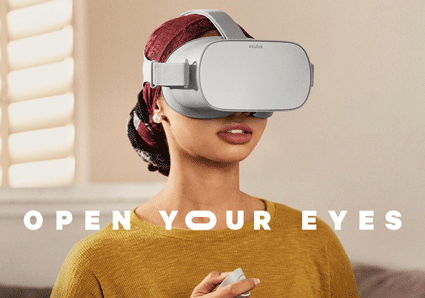Will Oculus Go kill the TV set?
A $199 VR headset aims to change the face of entertainment, but its greatest impact may be indirect. Chief Strategy Officer Brad Berens explains.
_______________________________________________________________________________________
By Brad Berens
Smart glasses, heads-up display, augmented reality, mixed reality, virtual reality: no matter what you call them, computer screens that you wear on your face are poised to change how we interact with information, the media we consume, and how much reality we share with people around us.
 It’s reasonable, for example, to expect that the smartphone will stop being our first screen if we’re always wearing displays that talk to us and show us things without our having to pull pieces of glass out of our pockets.
It’s reasonable, for example, to expect that the smartphone will stop being our first screen if we’re always wearing displays that talk to us and show us things without our having to pull pieces of glass out of our pockets.
But that’s not what this column is about.
Many of the smart-glasses-driven changes are off in the distance, but as I wrote in my last column, it’s important to pay attention to the future that’s already here. You can see that future today at Best Buy or with a few clicks at Amazon: it’s the $199 Oculus Go virtual reality headset created by Facebook.
The headset lets users “easily enter virtual reality with no PC or wires attached. Oculus Go is a standalone VR headset made to fit you. Designed with breathable fabrics, adjustable straps, and our best lenses yet.”
And it has Netflix built-in. The TV set as an independent device is doomed.
That’s what this column is about: the Oculus Go — and eventually other smart-glasses sets — makes having a second TV for families unnecessary and makes having a first TV optional for people living alone.
You won’t find Netflix prominently displayed on the Oculus Go website, but it’s there along with Hulu, YouTube and other streaming video.
What it’s like…
I was curious about the Go by itself, and also about what the streaming video experience would be like, and I’m fortunate to have Peter Lund as a friend. Peter is the COO of SuperGenius, a Portland-based software shop with special expertise in VR and video games. I visited his office to take the Go for a spin.
The glasses are lightweight and comfortable; the hand controllers are intuitive.
Nevertheless, all the usual VR slapstick comedy happened: not being able to see my hands or arms I clumsily knocked toys off his desk and lurched around in a chair as I twisted around to see what was behind me. (It was probably an amusing sight, but Peter is too polite to comment.)
_________________________________________________________________________________________________
So perhaps the Oculus Go will only doom the second TV set in the average American home. Why would you own more than one television if casual viewing can happen on smartphones, tablets and laptops, and immersive solo experiences are best in VR?
_________________________________________________________________________________________________
Things settled down, and I found myself in a virtual ski lodge with a gigantic TV screen on the wall in front me. In just a few seconds, I found myself watching the opening few minutes of Moana via Netflix.
Was it as crystal clear as the HD screen on the wall of my living room at home? No. But it was good– perfectly adequate for a solo-viewing experience. I can easily imagine watching a video in bed wearing an Oculus Go headset rather than on the living room couch. My wife would neither hear nor see anything, and afterwards I’d already be sleepy in bed. Lights out. G’night. Zzzzz.
What the experience is missing: co-viewing
I was being precise when I wrote that the Oculus Go is adequate for a solo-viewing experience: there’s no way for people to watch things together in real life, side-by-side on the living room couch.
There are ways to watch movies together on the Go in virtual theaters where your friends can send their avatars to the same theater at the same time, so a group of cartoons can all enjoy a live action movie together.
But for family movie night, watching the big game, the season finale to Dancing with the Stars, or catching the latest episode of a shared favorite TV series, the Oculus Go won’t cut it. Likewise, if you enjoy playing video games with other people in the same room (as opposed to online), you’ll still want a big screen on the wall… if you can wrangle everybody to the couch.
So perhaps the Oculus Go will only doom the second TV set in the average American home. Why would you own more than one television if casual viewing can happen on smartphones, tablets and laptops, and immersive solo experiences are best in VR?
Implications
Just as the smartphone absorbed a series of formerly independent devices (camera, flashlight, notepad, iPod, address book, calendar) and made them virtual, the Oculus Go has the potential to absorb and virtualize the TV set.
If this happens, then it will further advance the migration of Americans away from ad-supported entertainment on broadcast and cable TV and toward ad-free or ad-optional experiences on Netflix, Hulu, HBO and the like.
We can also expect a lot fewer TV sets on the market. By January of 2020, the crowded floor of TV displays at the annual Consumer Electronics Show might look like a barren lunar landscape.
The smartest move for Comcast, DIRECTV and their competitors would be to embrace the Oculus Go, create apps that pour the traditional TV experience into VR, and try to preserve their paying audiences for another generation.
__________

Brad Berens is the Center’s Chief Strategy Officer.
See all columns from the Center.
June 13, 2018

